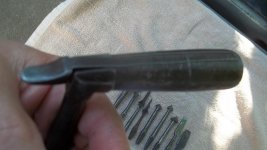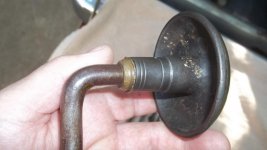Boringgeoff
Plastic
- Joined
- May 12, 2019
Hello,
I've had this small hand wrench for a few years but have been unable to find the original patent for it. It is marked "W.Lyon Pat 1874". I've trawled through all the US patents for 1874 and don't think I've missed any. Could be incorrectly dated or maybe not US patented? It has a square socket to fit old style square tapered tang auger bits or more likely square or hex bolt and nut sockets. The handle swings up and down to engage/disengage the five notches. Any ideas will be much appreciated.
Thanks in advance.
Geoff.
I've had this small hand wrench for a few years but have been unable to find the original patent for it. It is marked "W.Lyon Pat 1874". I've trawled through all the US patents for 1874 and don't think I've missed any. Could be incorrectly dated or maybe not US patented? It has a square socket to fit old style square tapered tang auger bits or more likely square or hex bolt and nut sockets. The handle swings up and down to engage/disengage the five notches. Any ideas will be much appreciated.
Thanks in advance.
Geoff.













